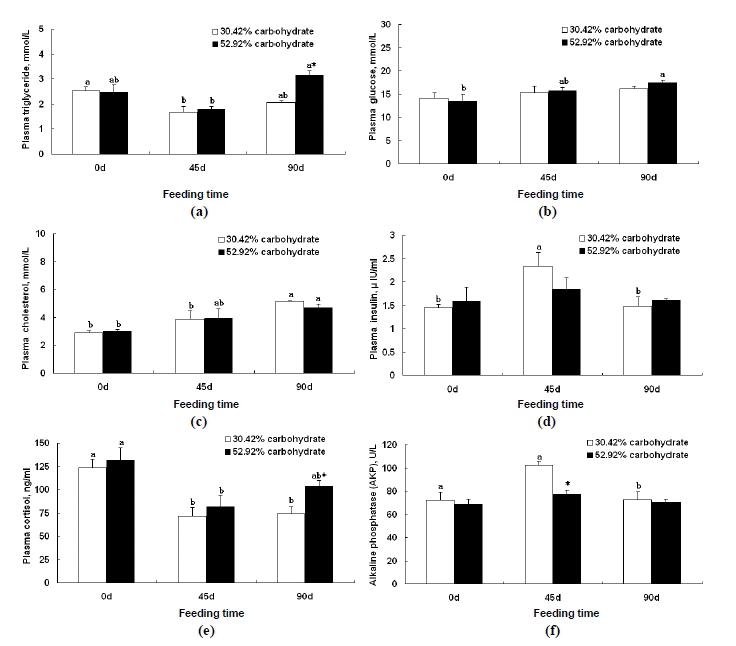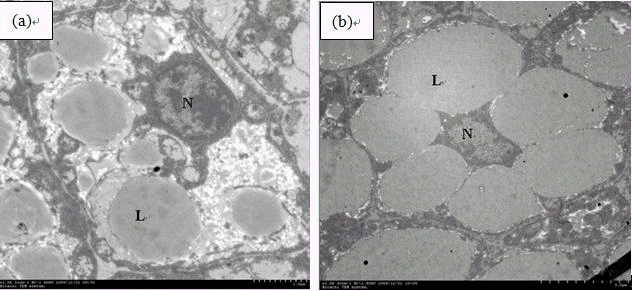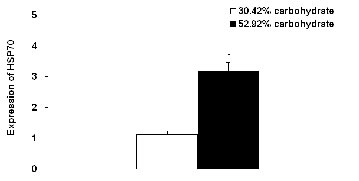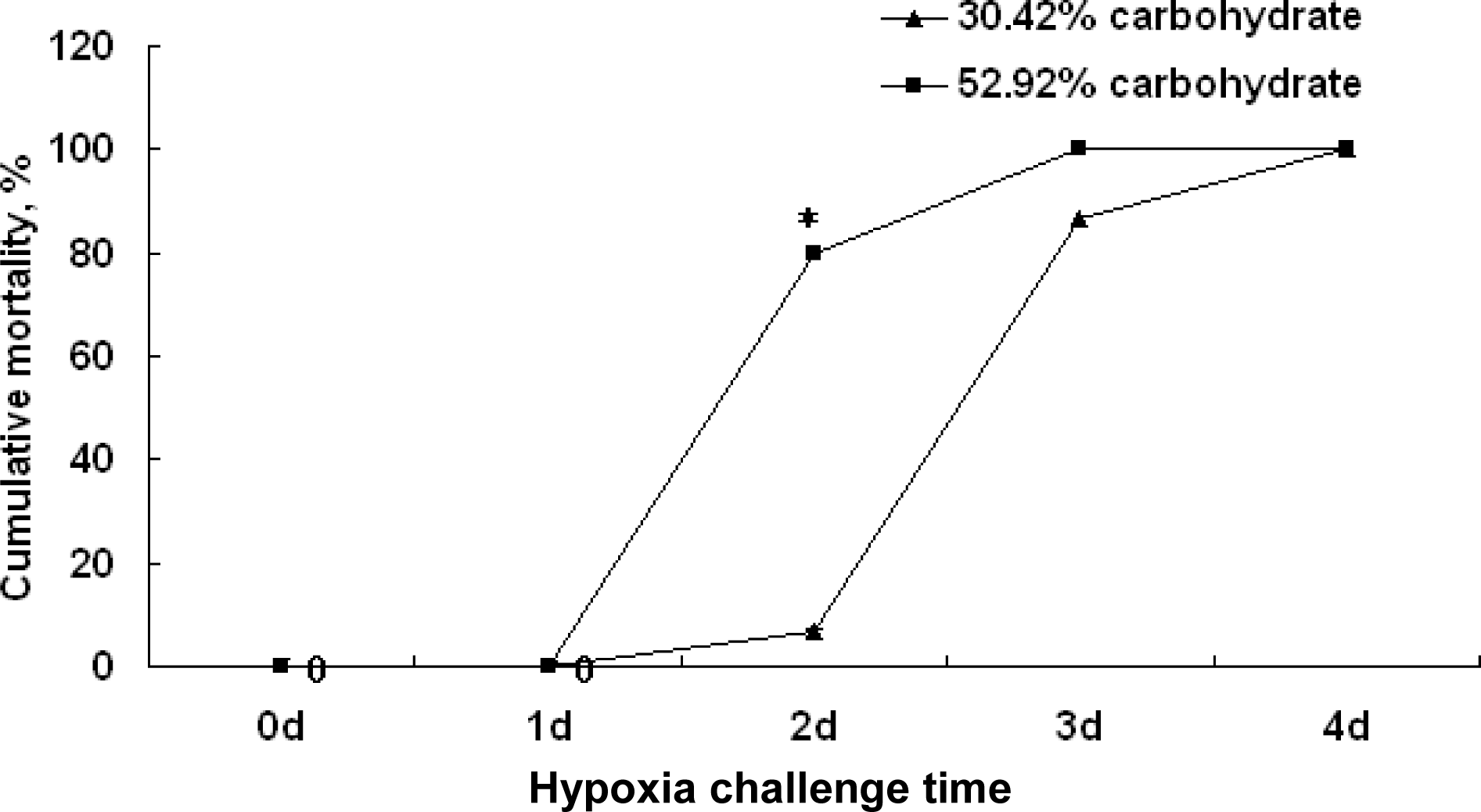Amoah A, Coyle SD, Webster CD, Durborrow RBM, Bright LA, Tidwell JH. 2008. Effects of graded levels of carbohydrate on growth and survival of largemouth bass,
Micropterus salmoides. J World Aquac Soc 39:397–405.

Arnesen P, Krogdahl A, Sundby A. 1995. Nutrient digestibilities, weight gain and plasma and liver levels of carbohydrate in Atlantic salmon (
Salmo salar, L.) fed diets containing oats and maize. Aquac Nutr 1:151–158.

Barton BA, Iwama GK. 1991. Physiological changes in fish from stress in aquaculture with emphasis on the response and effects of corticosteroids. Ann Rev Fish Dis 1:3–26.

Basu N, Todgham AE, Ackerman PA, Bibeau MR, Nakano K, Schulte PM, Iwama GK. 2002. Heat shock protein genes and their functional significance in fish. Gene 295:173–183.


Bergot F. 1979. Carbohydrate in rainbow trout diets: effects of the level and source of carbohydrate and the number of meals on growth and body composition. Aquaculture 18:157–167.

Bessey OA, Lowry OH, Brock MJ. 1946. A method for the rapid determination of alkaline phosphatase with five cubic millimeters of serum. J Biol Chem 164:321–329.


Brauge C, Medale F, Corraze G. 1994. Effect of dietary carbohydrate levels on growth, body composition and glycemia in rainbow trout,
Oncorhynchus mykiss, reared in seawater. Aquaculture 123:109–120.

Bunch EC, Bejerano I. 1997. The effect of environmental factors on the susceptibility of hybrid tilapia Oreochromis niloticus×Oreochromis aures to streptococcosis. Israel J Aquac 49:67–76.
Caballero MJ, Lopez-Calero G, Socorro J, Roo FJ, Izquierdo MS, Férnandez AJ. 1999. Combined effect of lipid level and fish meal quality on liver histology of gilthead seabream (
Sparus aurata). Aquaculture 179:277–290.

Chen WW, Cui LR, Yang CF. 2006. The study on Huangqi's protective role of lipid peroxidation injury during renal ischemia reperfusion in rats. Journal of Qiqihar Medical College 27:1666–1667.
Choi I, Lehmann DW, Harms CA, Law JM. 2007. Acute hypoxia-reperfusion triggers immunocompromise in Nile Tilipa. J Aquat Anim Health 19:128–140.


Clark P, Hales C. 1994. How to measure plasma insulin. Diabetes/Metabolism Rev 10:79

Cooper RU, Clough LM, Farwell MA, West TL. 2002. Hypoxia-induced metabolic and antioxidant enzymatic activities in the estuarine fish
Leiostomus xanthurus. J Exp Mar Biol Ecol 279:1–20.

Dabrowski K. 1990. Assay of ascorbic phosphate and bioavailability of ascorbic mono- and poly-phosphates. J Sci Food Agric 52:409–420.

Enes P, Panserat S, Kaushik S, Oliva-Teles A. 2008. Growth performance and metabolic utilization of diets with native and waxy maize starch by gilthead sea bream (
Sparus aurata) juveniles. Aquaculture 274:101–108.

Enes P, Panserat S, Kaushik S, Oliva-Teles A. 2006a. Effect of normal and waxy maize starch on growth, food utilization and hepatic glucose metabolism in European sea bass (
Dicentrarchus labrax) juveniles. Comp Biochem Physiol Part A Mol Integr Physiol 143:89–96.

Enes P, Panserat S, Kaushik S, Oliva-Teles A. 2006b. Rapid metabolic adaptation in European sea bass (
Dicentrarchus labrax) juveniles fed different carbohydrate sources after heat shock stress. Comp Biochem Physiol Part A Mol Integr Physiol 145:73–81.

Ellis AE. 1981. Stress and the modulation of defence mechanisms in fish. Pickering AD, editorStress in fish. London/New York: Academic Press; p. 147–69.
Erfanullah AKJ. 1995. Protein-sparing effect of dietary carbohydrate in diets for fingerling
Labeo rohita. Aquaculture 136:331–339.

Evans JJ, Shoemaker CA, Klesius PH. 2003. Effects of sublethal dissolved oxygen stress on blood glucose and susceptibility to
Streptococcus agalactiae in Nile tilapia
Oreochromis niloticus. J. Aquat. Anim. Health 15:202–208.

Fletcher TC. 1981. Dietary effects on stress and health. Iwama GK, Pickering AD, Sumpter JP, Schreck CB, editorsLondon/New York: Academic Press; p. 147–169.
Fletcher TC. 1997. Dietary effects on stress and health In: Fish Stress and Health in Aquaculture. Iwama GK, Pickering AD, Sumpter JP, Schreck CB, editorsCambridge Univ. Press; Cambridge, UK: p. 223–246.
Fu SJ, Xie XJ. 2005. Effect of dietary carbohydrate levels on growth performance in Silurus meridionalis Chen. Acta Hydrobiol Sin 29:393–398.
Gao W, Liu YJ, Tian LX, Mai KS, Liang GY, Yang HJ, Huai MY, Luo WJ. 2010. Effect of dietary carbohydrate-to-lipid ratios on growth performance, body composition, nutrient utilization and hepatic enzymes activities of herbivorous grass carp (
Ctenopharyngodon idella). Aquac Nutr 16:327–333.

Ge XP, Liu B, Xie J, Yu JH, Tang YK, Wu TT. 2007. Effect of different carbohydrate levels of dietary on growth, plasma biochemical indices and hepatic pancreas carbohydrate metabolic enzymes in top mouth culter (Erythroculter ilishaeformis Bleeker). J Nanjing Agric Univ 30:88–93.
Gu J, Gong JH, Yin YB, Li J. 1995. Effects of intermittent hyperbaric oxygen exposure and oxygen convulsions on a trioxidant enzyme activity and lipid peroxide contents in rats. Chinese J Nautr Med 2:31–34.
He SX, Xu JL, Zhao G, Wang YL, Fu H, Li HX, Chang XM. 2007. Effects of Salvia miltiorrhiza bunge injection on the status of lipid peroxidation in liver cirrhosis patients with massive upper gastrointestinal hemorrhage. World Chinese J Digestol 15:181–184.

Hemre GI, Lambertsen G, Lie Ø. 1991. The effect of dietary carbohydrate on the stress response in cod (
Gadus morhua). Aquaculture 95:319–328.

Hemre GI, Mommsen TP, Krogdahl Å. 2002. Carbohydrates in fish nutrition: effects on growth, glucose metabolism and hepatic enzymes. Aquac Nutr 8:175–194.

Hemre GI, Sandnes K, Lie Ø, Waagbø R. 1995. Blood chemistry and organ nutrient composition in Atlantic salmon,
Salmo salar L., fed graded amounts of wheat starch. Aquac Nutr 1:37–42.

Hilton JW, Plisetskaya EM, Leatherland JF. 1987. Does oral 3,5,3′-triiodo-l-thyronine affect dietary glucose utilization and plasma insulin levels in rainbow trout (
Salmo gairdneri)? Fish Physiol Biochem 4:113–120.


Iwama GK, Pickering AD, Sumpter JP, Schreck CB. 1997. Fish Stress and Health in Aquaculture. Society for Experimental Biology Seminar Series. 62:Society for Experimental Biology; Great Britain: p. 278
Jauncey K. 1982. Carp (Cyprinus carpio L) nutrition - a review. Recent advances in aquaculture. Muir JF, Roberts RJ, editorsCroom Helm Ltd; London: p. 215–263.
Ke H. 1975. An excellent freshwater food fish, Megalobrama amblycephala, and its propagating and culturing. Acta Hydrobiol Sin 5:293–312.
Ke H. 1986. Cultivation of blunt snout bream (Megalobrama amblycephala) in China. Fisheries Science and Technology Information 5:1–5.
Krogdahl Å, Hemre GI, Mommsen TP. 2005. Carbohydrates in fish nutrition: digestion and absorption in postlarval stages. Aquac Nutr 11:103–122.

Kumar S, Sahu NP, Pal AK, Choudhury D, Yengkokpam S, Mukherjee SC. 2005. Effect of dietary carbohydrate on haematology, respiratory burst activity and histological changes in
L. rohita juveniles. Fish Shellfish Immunol 19:331–344.


Lall SP. 1991. Salmonid nutrition and feed production. Proceedings of the special session on salmonid aquaculture. Cook RH, Pennel W, editorsWorld Aquaculture Society. Los Angeles; CA: p. 107–123.
Li XF, Liu WB, Jiang YY, Zhu H, Ge XP. 2010. Effects of dietary protein and lipid levels in practical diets on growth performance and body composition of blunt snout bream (
Megalobrama amblycephala) fingerlings. Aquaculture 303:65–70.

Li XF, Jiang YY, Liu WB, Ge XP. 2012. Protein-sparing effect of dietary lipid in practical diets for blunt snout bream (
Megalobrama amblycephala) fingerlings: effects on digestive and metabolic responses. Fish Physiol Biochem 38:529–541.


Liu B, Ge XP, Xie J, Xu P, He YJ, Cui YT, Ming JH, Zhou QL, Pan LK. 2012. Effects of anthraquinone extract from
Rheum officinale Bail on the physiological responses and HSP70 gene expression of
Megalobrama amblycephala under
Aeromonas hydrophila infection. Fish Shellfish Immunol 32:1–7.


Liu B, Xie J, Su YT, Yu JH, Tang YK, Ge XP. 2008. Effect of high carbohydrate levels of dietary on growth, GK activities and GK mRNA levels in top mouth culter (
Erythroculter ilishaeformis Bleeker). Acta Hydrobiol Sin 1:47–53.

Liu MZ, Shi WL, Zhu CW, Lu MY, Wang GL, Wang FQ. 1992. The effect of dietary lipid level on the growth of blunt snout bream (Megalobrama amblycephala) fingerling. Journal of Fisheries of China 4:330–336.
Livak KJ, Schmittgen TD. 2001. Analysis of relative gene expression data using Real-time quantitative PCR and the 2
−ΔΔCT method. Methods 25:402–408.


Luo YP, Xie XJ. 2010. Effects of high carbohydrate and high lipid diets on growth, body composition and glucose metabolism in southern catfish at two temperatures. Aquac Res 41:431–437.

Marklund S, Marklund G. 1974. Involvement of the superoxide anion radical in the autoxidation of pyrogallol and a convenient assay for superoxide dismutase. Eur J Biochem 47:469–474.


Maule AG, Tripp RA, Kaattari SL, Schreck CB. 1989. Stress alters the immune function and disease resistance in Chinook salmon (
Oncorhynchus tshawytscha). J Endocrinol 120:135–142.


Miao LH, Ge XP, Xie J, Liu B, Pan LK, Zhou QL, Chen RL. 2011. Effect of high dietary carbohydrates on plasma cortisol levels and HSP70 expression in allogynogenetic crucian carp (
Carassius auratus gibelio). J. Fishery Sci. China 18:819–827. (in Chinese, with English abstract).

Ming JH, Xie J, Xu P, Liu WB, Ge XP, Liu B, He YJ, Cheng YF, Zhou QL, Pan LK. 2010. Molecular cloning and expression of two HSP70 genes in the Wuchang bream (
Megalobrama amblycephala Yih). Fish Shellfish Immunol 28:407–418.


Mohapatra M, Sahu NP, Chaudhari A. 2003. Utilization of gelatinized carbohydrate in diets in
Labeo rohita fry. Aquac Nutr 9:189–196.

Ou YM, Yu X, Chen DY. 2001. Preliminary study on the oxygen consumption rate and asphyxiant point of Wuchang bream in Poyang Lake. Fisheries Science and Technology in Jiangxi 88:20–22.
Pickering AD, Pottinger P. 1983. Seasonal and diet changes in plasma cortisol levels of the brown trout,
Salmo trutta L. Gen Comp Endocrinol 49:232–239.


Pieper A, Pfeffer E. 1980. Studies on the effect of increasing proportions of sucrose or gelatinized maize starch in diets for rainbow trout (
Salmo gairdneri, R.) on the utilization of dietary energy and protein. Aquaculture 20:333–342.

Plummer P. 1987. Glycogen determination in animal tissues An Introduction to Practical Biochemistry. 3rd ednMcGraw Hill Book; Maidenhead: p. 332
Roberts RJ. 1989. Nutritional pathology of teleosts. Fish pathology. Roberts RJ, editorBailliere Tindall; London: p. 337–362.
Roberts RJ, Bullock AM. 1989. Nutritional pathology. Fish nutrition. Halver JE, editorAcademic Press Inc; London: p. 423–473.

Shi WL, Shan J, Liu MZ, Yan H, Huang FQ, Zhou XW, Shen L. 1988. A study of the optimum demand of protein by blunt snout bream (Megalobrama amblycephala). FAO library. Report No: FAO-FI–RAS/86/047; FAO-FI–NACA/WP/88/68. Accession No: 289611.
Singh RK, Balange AK, Ghughuskar MM. 2006. Protein sparing effect of carbohydrates in the diet of Cirrhinus mrigala (Hamilton, 1822) fry. Aquaculture 258:680–684.

Strickland JDA, Parsons TR. 1968. A practical handbook of seawater analysis, Fish. Res Board Can Bull 167:1–11.
Tan QS, Wang F, Xie SQ, Zhu XM, Lei W, Shen JZ. 2009. Effect of high dietary starch levels on the growth performance, blood chemistry and body composition of gibelio crucian carp (
Carassius auratus var. gibelio). Aquaculture Res 40:1011–1018.

Vielma J, Koskela J, Ruohonen K, Jokinen I, Kettunen J. 2003. Optimal diet composition for European whitefish (
Coregonus lavaretus): carbohydrate stress and immune parameter responses. Aquaculture 225:3–16.

Waagbø R, Glette J, Sandnes K, Hemre GI. 1994. Influence of dietary carbohydrate on blood chemistry, immunity and disease resistance in Atlantic salmon,
Salmo salar L. J Fish Dis 17:245–258.

Wendelaar Bonga SE. 1997. The stress response in fish. Physiol Rev 77:591–625.


Wiik R, Andersen K, Ulgenes I, Egidius E. 1989. Cortisol-induced increase in susceptibility of Atlantic salmon, Salmo salar together with effects on the blood cell pattern. Aquaculture 83:201–215.

Wilson RP. 1994. Utilization of dietary carbohydrate by fish. Aquaculture 124:67–80.

Xiang R, Wang DN. 1990. The improvement of the method spectrophotometer on lipid peroxides thiobarbituric acid. Progress in Biochemistry and Biophysics l7:241–242.
Yang GH, Dai QX, Gu LD. 1989. Nutrition, feed formulation and high-yield aquaculture techniques of blunt snout bream (Megalobrama amblycephala). Feed Industry 1:7–10.
Zhou JB, Zhou QC, Chi SY, Yang QH, Liu CW. 2007. Optimal dietary protein requirement for juvenile ivory shell, Babylonia areolata. Aquaculture 270:186–192.

Zhu SQ. 1995. Synopsis of Freshwater Fishes of China. Jiangsu Science and Technology Publishing House; Nanjing, Jiangsu, China:
Zhou WY, Yu CY, Liu JZ, Yang GH. 1997. Effects of quality and quantity of fat in diet on growth of blunt snout bream (Megalobrama amblycephala). Fish Sci Technol Inf 1:3–9.
Zhou Z, Ren Z, Zeng H, Yao B. 2008. Apparent digestibility of various feedstuffs for blunt nose black bream
Megalobrama amblycephala Yih. Aquac Nutr 14:153–165.

Zou Z, Yuan F, Chen S. 1987. The optimal protein requirement of blunt nose black bream Megalobrama amblycephala Yih. Freshwater Fisheries 3:21–24.













 PDF Links
PDF Links PubReader
PubReader ePub Link
ePub Link Full text via DOI
Full text via DOI Full text via PMC
Full text via PMC Download Citation
Download Citation Print
Print





